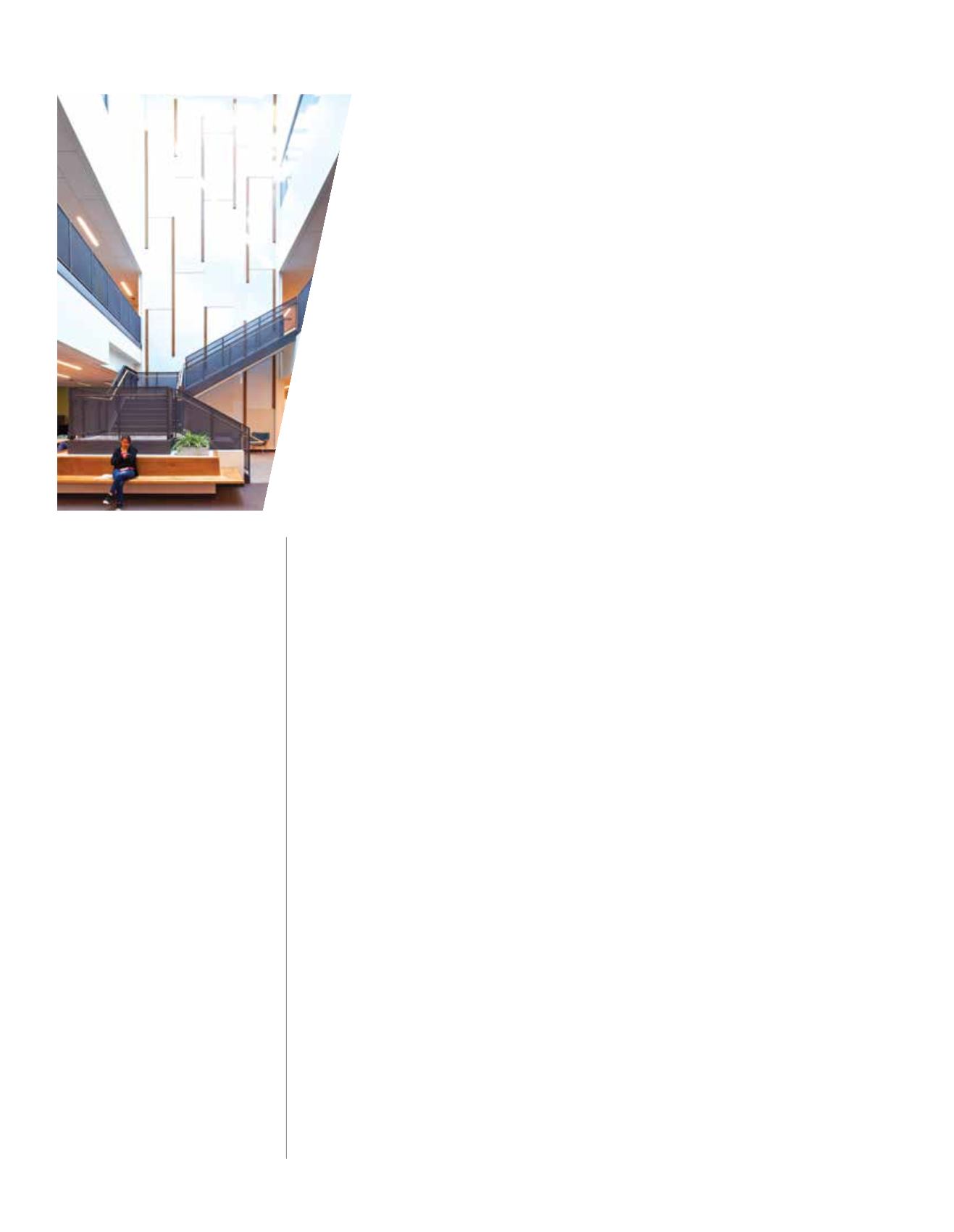

80
/ BUILDING DIALOGUE / JUNE 2017
/ St. Vrain Community Hub /
parking lot and the street, presented a series of unusual design considerations.
Our solution was to design dual entries for users and staff, each of which would
feel like the primary entrance.
In order to create a space that avoided feeling like an unwelcoming govern-
ment building, we planned a spacious and open central lobby featuring a grand
staircase, a balcony encircling the second floor and the installation of windows to
allow light to penetrate into the building from the third level. Reclaimed lumber
salvaged from a nearby church added soft, warm tones. The result is an inviting
interior flooded with daylight from a large skylight and clerestory windows and fea-
tures clean, modern lines and warmwood trim.
“It has become a gathering place for the community,” says Chris Saunders, Boulder
Country Housing & Human Services Program Operations manager. “People come to
hang out there just because it feels good.”
What’s more, research showed that clients often felt confused about where to go
upon arrival, so we designed a lobby “navigation station,” giving visitors a designated
starting point in locating their destination. From there, they move to one of the many
private, multi-usemeeting rooms where staff fromeach of the assisting departments can
work with them in a one-on-one setting.
It was also critical to the county that the building reflect the high value they place
on sustainability and stewardship of resources. Accordingly, we set to work ensuring
that the new facility would achieve the highest LEED rating (Platinum) and achieve
exceptional levels of energy savings, water reduction, CO2 emissions reductions and
high indoor air quality.
Acquiring LEED Platinumcertification required extensive early planning and aggressive
goal setting. In fact, the desire for LEED Platinum certification played a critical role in the
initial site selection, with the building intentionally sited in downtown Longmont, just a
block fromthemain bus terminal and central to businesses and services. Encouraging and
facilitating alternative transportation also led to the inclusion of a bikemaintenance area,
outdoor and covered bike racks and electric vehicle charging stations around the building.
Other sustainable elements of the project included onsite recycling and composting
with a station for hard-to-recycle items and composting in the bathrooms, a garden with
plants native to the area, and rain gardens for stormwater management. Additionally,
bringing in as much natural light as possible in order to cut down on the use of light
fixtures was a top priority. The final campus is filled with daylight via interior light wells
and skylights, solar tubes and open offices along perimeter walls. Ultimately, the St. Vrain
Community Hub building design will result in a 48-percent reduction in energy use and
43 percent energy cost savings.
The interior office design fosters intradepartmental interaction and communication
and takes into account the desire among the staff for areas of separation where they can
take refuge from what is frequently a demanding job. Workers now have formal and in-
formal meeting areas, a pocket park outside, training rooms, a fitness area, work cafés on
each floor and a “retreat space” where they can work privately with clients in distress or
who are going through extremely challenging situations.
In the new building, offices are better designed to accommodate both resident workers
who spendmore than 50 percent of their time in the office, as well asmobile workers who
spend more than 50 percent of their time out of the office. We designed dedicated work-
spaces and private offices for resident workers, while mobile workers can choose from
unassigned touch-down spaces or a variety of other work settings when they are on-site
in the office. Varying “neighborhoods” were created with designated zones for working
quietly, collaboratively or actively.
Because Boulder County anticipates that workspace needs will change significantly as
integrations and client processes change, the space was also designed with flexibility in
mind. Workstation layouts and furniture dimensions were carefully studied and laid out
to allow for more to be added in the future withminimal disruption to the built environ-
ment.
Most importantly for the building’s employees and clients, however, is that it feels warm,
welcoming and inclusive.
“The building reflects the culture of Boulder County Health andHuman Services,” Saun-
ders says. “When people walk through the space they understand our vision that any door
is the right door.”
With the St. Vrain Community Hub, OZ Architecture has created a government building
equipped for the future, and one to serve as a model for others around the U.S. Its sustain-
able, appealing, functional and thoughtful design offers tremendous benefits tomembers
of the community who seek out services there and the staff who provide them.
\\
PHOTOS:
James Ray Spahn
OPENING ART:
Comfortable and colorful
seating in the spacious
lobby plays off reclaimed
lumber and for a warm and
modern setting.
ABOVE:
The grand staircase in the
expansive central lobby
fills with daylight from
clerestory windows and
upper skylight.
PROJECT TEAM
ARCHITECT/INTERIOR DESIGN:
OZ Architecture
CLIENT:
Boulder County Building Services
ENGINEERS: MECHANICAL,
ELECTRICAL & PLUMBING:
RMH Group;
STRUCTURAL:
SCI;
CIVIL:
JVA
GENERAL CONTRACTOR:
Adolfson & Peterson Construction
LANDSCAPE ARCHITECT:
PCS Group
















